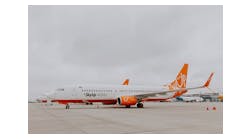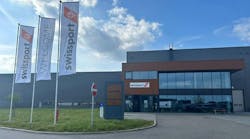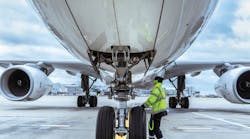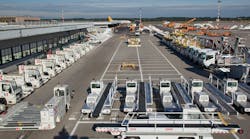Nashville is one of the fastest growing metropolitan areas in North America. With more people comes more travelers passing through Nashville International Airport (BNA).
Now the airport is building on this growth and preparing to get ahead of the boom in the community by investing more than $1 billion in improvements to its passenger terminal outlined in its BNA Vision plan. Airport Business recently spoke with Nashville Airport Authority President and CEO Doug Kreulen about BNA Vision and why the airport is seeing so much growth in recent years.
Airport Business: You took over as CEO of the airport authority about one year ago. What do you see as the biggest challenges facing Nashville?
Doug Kreulen: First off, being in there for only a year is assembling the right team of leaders at the airport to help me out. We’ve done a big job to hire a new executive staff and senior staff to keep things moving in the right direction. We’ve got the right people in the right places, so we’re catching up with all the day-to-day activity that’s required to run an airport. We’re also right in the middle of BNA Vision and everyone is really focused on that, our five-year capital plan to keep up with the growth of Nashville. We’re going to spend about $1.2 billion; we’re going to add about 500,000 square feet to the airport in terms of the terminal and the concourses; and it’s going to take us about five years to do that.
AB: Nashville is one of the fastest growing airports in the country. What’s driving this growth?
DK: We’ve got a heck of a tourism industry in Nashville. The Music City Center opened about four or five years ago and the number of conventions they book is growing leaps and bounds. We also have an awesome healthcare component to our economy and the music industry itself. It’s just a great place to come visit. I’m sitting here looking at our new aviation forecast for our master plan that we’re working on and it basically shows that it’s going to keep growing for another 20 years or so.
AB: So the predominant growth is coming from the tourism side or business side?
DK: It’s both business and tourism. If you look at the chamber of commerce, they touted anywhere between 80 and 100 people moving to Nashville every day. The population growth in this new forecast, in our catchment area is 1.86 million today and over the next 20 years it’s going to grow by 1 million to 2.6 million. We’re expanding about as fast as we can to try and keep up with this growth. Today we’re at a little over 14 million at the end of last year in terms of enplanements and deplanements total, but by the time I finish the BNA Vision in 2023, I’ll already be at 18 million.
AB: Memphis was historically the big traffic airport in that region. Has it been a challenge in making sure the air traffic system works right with this change in traffic patterns?
DK: I don’t think so. I work very closely with Scott Brockman at Memphis. He’s a mentor of mine. We exchange ideas on how things are going back and forth. We in Nashville understand what he’s going through because when American de-hubbed with us in 1992, it has taken us 20 years to get to where we’re at today. We’re switching from that type of hub and transit market to an O&D and today we’re 88 percent O&D and 12 percent thru traffic.
AB: With passenger volumes projected to reach 23 million by 2037, how prepared are you for this growth?
DK: We’re doing a better job of focusing on the long-term future. We’ve got a new strategic plan that talks about how it’s our job as airport professionals to look farther out into the future. The BNA Vision is going to take care of getting us to that 23 million. We’re now working on the master plan for what comes beyond that time period. We’re building and we’re already focused on what comes after BNA Vision. We won’t finish that for another year or so, but I think we’re going to have new metrics going forward that won’t allow us get caught a little behind the power curve if we keep growing like this.
AB: BNA Vision is such a massive project. What spurred it and what do you see as the impact?
DK: We do monthly board meetings like any other airport and as you keep doing those meetings you keep reporting that passenger traffic is up 6 percent. It’s up 7 percent. It’s up 8 percent. You’re wonder how long this can go on and what do we need to do. We pulled out the old 2013 master plan and we started using that as a reference document and found that if we go on like this we’re two years behind, three years behind, four years behind. We knew we couldn’t allow ourselves to get that far behind, so we kicked off the BNA Vision initiative to try and make one big jump and get out ahead of all of this and then probably do a better job of tracking that as we go forward.
AB: Building the new parking structure as part of BNA Vision, are there concerns with all the talk of impact of TNCs on parking revenues?
DK: We were the first airport in October 2014 to make a license with Uber and Lyft, and they have been widely successful here. They went from 5,000 trips per month combined to 85,000 trips per month. As we build these new parking and transportation centers, we’ve made sure the bottom floor has ceiling heights of 14 feet so they can handle any size vehicle from normal Uber or Lyft to personal vehicles to shuttle buses to bus rapid transit. We envision sometime down the road autonomous vehicles will play some part in Nashville. This is a one-time shot to get the BNA Vision right, so we’re consolidating all that garage right in the front door of the airport. If you come and park at Nashville Airport, we will eventually end up with 7,000 spaces that you can park and walk about 100 to 150 feet and you’ll be in the terminal. Also, if you’re using public transportation, Uber, Lyft hotel shuttles or a bus that goes to downtown Nashville, you have that same 150 foot walk across the road and you’re right inside. The parking for us is an investment with that first-class service we’re trying to provide.
AB: There’s a big push to enhance ticketing and dining in the BNA Vision, how did you come to the planning on this? Was it passenger driven or from operations?
DK: A little bit of both. Our city, besides being a beautiful city that supports tourism and the music industry and healthcare, we feel like we have a Nashville sense of place in the terminal. We’ve reached out to the local businesses here and they want to be more of a participant with us in our future concessions program. We like to say that we’re the first impression when they arrive and we’re the last impression when they depart, so it’s really important for us that our new mall concept reflects what they see downtown, so you’ll feel like you’re in Nashville the minute you step off the airplane.
AB: What were the travelers in the community telling you they wanted to see focus on with BNA Vision improvements?
DK: They wanted a higher quality of food and beverages and in the same way with the shopping opportunities. We like that idea because it generates additional revenue for the airport, but as anybody travels with our security regulations, you try to get here a couple of hours before the flight and you want to be able to enjoy yourself and shop for something to take to your friends and family. We’re also growing out of a small-medium sized, medium hub to a large-medium hub and maybe someday to a large hub. We’re now operating almost 22 hours per day, so we didn’t want to stay and offer the same sorts of services from 6 a.m. to 6 p.m. We’ve got flights departing at 4 a.m. and 5 a.m. and not landing until Midnight, so we wanted to offer all of our passengers more of those comforts they’d appreciate coming or going.
AB: Can you tell me about Nashville’s recent plans to overhaul its concessions and why you’re looking at the developer model?
DK: We’re excited about the possibility of doing the developer model. When we started working with our board in the January time period, they gave us some pretty clear goals and improve customer service was No. 1. If you look at the passenger surveys we’ve done, we’re normally in all the different types of things like security, restroom cleanliness, we’re getting grades around 94-95. But if you look at our food and beverage or retail, we’re at a 70-72. We wanted to improve customer service, we wanted the lower prices for our customers so we could increase sales and we really put the bar out there to increase local participation and the same with our ACDBE. We’re picking a partner that we wanted 40 to 45 percent local participation and they think they can get 90 percent. On minority participation, we’re looking for somewhere around 22 to 25 percent and they think they can get it at 40 percent. That will be a homerun for our community. Lastly, the developer model also gives us an opportunity with whomever is selected, invest some capital in the airport. As we do BNA Vision we will spend $1.2 billion and we’ll get a new concourse, we will get a new parking and transportation center, we will get a new central terminal and marketplace with six new gates. That will spend $1 billion in a heartbeat. We want this new developer to come in and invest capital with us to renovate Concourses A, B and C so in the end, when we finish the whole BNA Vision, the whole airport looks brand new and our customers look happy.
AB: When do you expect to start seeing operation impacts from BNA Vision and how are you preparing?
DK: If you ask my board, they’ll tell you there better not be any operational impact. Airfield wise, I don’t think we will have any operational impacts. Every Thursday morning, we do BNA Vision planning meetings. The first half of the meeting is all focused on the customer and what’s going on. As we grow and construct, we’re really focused on how are we communicating the impact of this construction. Customer Smith comes No. 1 for us. We want him to be able to get off the highway, get into parking, get into the terminal and onto the concourses without a lot of confusion or any problems. I think we’re doing a good job of that so far. We’ve still be getting pretty good reports and grades from our passengers during our surveys. When we started more than a year and a half ago, we had 10 security lanes. A few weeks ago we opened our eleventh and twelfth lanes. We’re building our thirteenth and fourteenth lane. When we get our ticketing wings in the next year and a half, we’ll have 18 lanes. That’s right before we split the airport in two, so you’ll either be on the C-D side or the A-B side. It’s all about getting the passengers in through ticketing, in past security and onto the gates. In the last two or three years of BNA Vision, nobody will be in the center of the airport and that’s where we’re basically expanding into the full 24 lanes, building the shopping mall inside the center terminal and we’ll eventually end up with six international gates as well.
AB: British Airways started servicing the airport in May. How has the community embraced it?
DK: The community has really been a great help with convincing British Airways that Nashville is worth the risk. We’re the smallest market they have ever entered in the U.S. We worked very hard to convince them that there’s something special going on in Nashville. Once they got here and were able to see it, think the truly appreciated it. The state, the city, the airport authority, we’ve done everything we could to assist them. We built a new 25,000 square foot catering facility. The first month they operated, the load factors were 90.8 percent. The first 20 days of June it’s 94.8 percent. Needless to say, they’re pretty tickled that there’s about four or five seats every flight that are not filled.
AB: Are you focusing on more international? What markets?
DK: They definitely would love for us to go to Asia. We’re doing some planning to make sure we have the right runway lengths for nonstop service to Asia. We’re also looking at other opportunities in Europe along with Central and South America. When we brought in British Airways, we did an $8 million renovation of our existing international arrivals facility, which basically gave us the capability to receive two aircraft simultaneously and process 400 passengers per hour. The new BNA Vision Nashville facility will go up to six gates and 800 people per hour. The master plan shows we’re going to have a couple hundred percent increase over the next 20 years and international travel, it will be Europe, Central and South America and one of these days, Asia.
AB: How about domestic destinations?
DK: It really goes back to the different industries. I know when I go out and make presentations, Portland is one they really want to get ahold of because it will help them with healthcare and specifically healthcare IT. Richmond, we have a couple days per week service to them, but they want daily service for our insurance industry. We try to look at it by industry and by passengers. It evolves on what seems and monthly or quarterly basis that we’re always looking for a new target.





